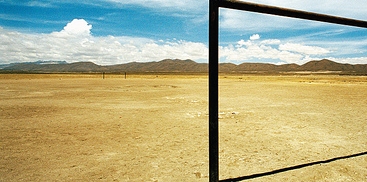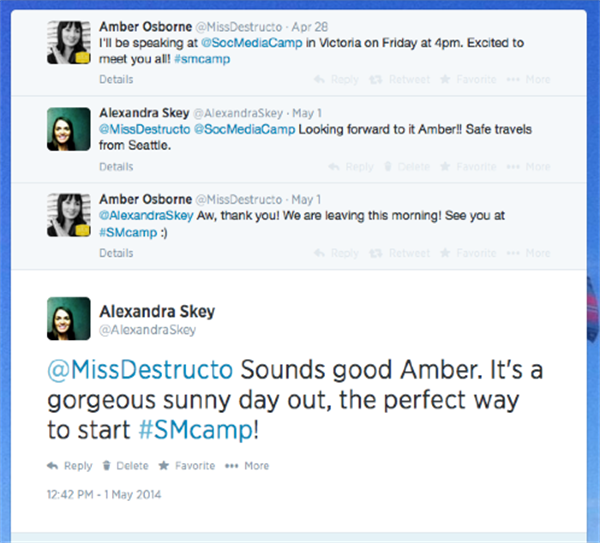I love events.
I’m one of those people that thrives on the energy of a crowd.
I love meeting strangers. I love the awkward pauses. And I love the “great unknown” of what can happen when we all get together to talk shop.
In fact, the only thing I don’t like about events are the cheap coffee and small name tags (no matter how often I spell “Alexandra,” the “ndra” always gets squished together so it looks like one letter).
So, when Chris and I started Spokal over 2 years ago, I went to a ton of events.
They were great.
There was only one problem – our company wasn’t growing as fast as we wanted. When we started looking at how much time we were spending at events, and what we were actually doing there, the ball dropped.
I realized I was drinking the event Kool-Aid.
To rock a networking event, and make sure you don’t get overwhelmed by the sweet temptation, you need to do these 4 essential things.
1. Set Specific Goals
Why are you going to the event?
This sounds like a silly question.
But it’s one that doesn’t get asked enough.
Events take time. Time is your most precious resource.
While you may be diligent about how much time you spend with clients or on a project, I imagine you’re not as diligent when it comes to events. Specifically, understanding the full time it takes.
In addition to the scheduled event, let’s say it’s 5-7pm, there’s travel time, prep time, unwinding time (I always overestimate my ability to work right after an event) and follow up time.
So, what may seem like a quick hour or 2 can actually be a 4-6 hour commitment.
Being realistic about this will help you realize the importance of setting goals for the event.
What do you want to achieve?
- Are you looking for guest blogging opportunities?
- Customers?
- Someone to help you with contract work?
- A teammate or cofounder?
- Someone specific?
- An introduction to someone specific?
- To learn what’s happening right now in your industry?
- Meet your competitors?
- Meet past clients?
- Practice your networking skills?
- Refine your pitch?
- Find someone to help you with a specific project?
- Find a way to help someone else?
- Lay the foundation for a partnership?
- Get inspiration?
The list is endless.
Once you know what you want, then you can ask the hard question: Is this the best way to achieve it?
When Chris and I were hitting the event circuit, we wanted customers.
We knew that going to events was a great way to hear what people were saying about Spokal, what they liked and didn’t like, and what they were looking for in general from a solution like ours.
But it didn’t make sense to go to events to get customers, once we realized that’s what we needed.
For example, say we went to a 2 hour small business event with 100 service professionals. Say we spoke with 25 of them (we’re keen). Say of those 25, 5 were interested in what we did. Say 2 or 3 followed up with their free Spokal trial. And say 1 or 2 converted.
That means Chris and I spent at least 4 hours getting 1 customer.
Businesses pay us $50/month to use Spokal, so that’s not a scalable strategy. When we decided to change and focus our growth on inbound marketing online, we blossomed.
We still go to events, and now we have a very specific idea of what we want to achieve at each one.
2. Do Your Prep
Once you know why you’re going to an event, you can do your homework.
If you’re going to meet someone specific, contact them ahead of time. The goal is to let them know you’re going and that you’re looking forward to seeing them there.
If it’s a big event or a conference, the pre-hello email is a great way to set up a time or place to meet and grab a coffee. Otherwise, make sure you know what they look like, so you can scan the crowd and zone in when you find them.
If you’re not sure who you want to meet, scan the guest list.
Most events are hosted with an online company, like Evenbrite, and many make their attendees list public. Scan the list, identify who you want to meet, and if possible, get in touch ahead of time. If you don’t have their email, ping them on Twitter.
Here’s the secret – a lot of people are doing this, especially for bigger events. So, make sure your conversation is unique and relevant.
That means doing your job ahead of time and finding out who they are, what they like, where they live (aka are they coming out of town or is it a local event?) and so on.
I had a fun conversation with Meshfire’s Amber Osborne at Social Media Camp last month.
She was from Seattle, so our tweets started off with me responding for her to get ready for the sun, because it was going to be a sunny week in Victoria.
When we finally met, we already “knew each other,” so it was easy to pick up the conversation and start a relationship.
This happens all the time.
If you don’t have time to prep, you don’t have time to go.
3. Be Present
This is where the magic happens.
When you show up to an event, you need to be present.
This means getting off your phone.
Yes, of course you can (and should) use twitter hashtags to chat with people who are also there. But don’t text people who aren’t there or aren’t coming, don’t respond to emails and don’t read your favourite news feed.
Don’t pretend to be busy to avoid the awkwardness.
Mingle.
The first 10 minutes of an event is always uncomfortable. It takes time to scan the room, grab a drink, get the lay of the land and relax into it.
Even Yahoo’s Marissa Mayer doesn’t like it.
She tells herself she only has to stay for 15 minutes, and if she’s not having fun, she can leave. Of course, she finds that she usually is having fun by then and ends up staying.
Once you know about the inevitable awkwardness, you can embrace it.
And eventually, learn to love it.
4. Follow Up Like Crazy
This is where most of us, including myself, fail.
Especially if you’ve spent time doing your homework, traveling to the event, and given yourself time to come down from your post event high.
Another 20-30 minutes to follow up doesn’t seem as pressing compared to your recently neglected to do list.
But this is also the most important step.
It’s where you make sure that the goal you set out to achieve was made.
The best follow up has 2 stages: Outreach + Housekeeping.
Outreach
The sooner you follow up, the better.
I’ve heard people say that you should follow up within 24 hours, I say 1 week maximum, depending on the size of the event.
If you really miss the boat, you can say something like: “Remember that time we met at the Small Business Breakfast event? Can you believe it’s been 29 days?!”
I’ve done that one before, and it usually gets a good response.
When you follow up, more often than not you default to email.
And depending on the relationship you’re forming, you may want to call someone instead. I find it more enjoyable spending 5 minutes on the phone than in my inbox, and I’m sure I’m not the only one.
If they’re avid online, you can also follow up using their preferred social channels.
Housekeeping
In addition to outreach, you need to keep your records straight.
Snap their business card information into your CRM, or simply use CardMunch or another app that pulls data from business cards into one place.
And always write a quick note beside each person.
While you may not need it today, it’s hard to remember what you talked about with everyone, especially as the weeks roll by. Details will help you stay relevant, which is why it’s important to keep in mind if if they have 3 kids, love kiteboarding and always watch the cooking channel.
If you’re active online, feel free to follow their social profiles. If you really want to build a relationship, chat with them online, comment on their articles (if possible) and share their content.
Of course, it doesn’t end there.
The more proactive you can be, the better.
Depending on your original goal, you probably have an action item and follow up already scheduled. Even if that doesn’t go according to plan, it’s important to keep your relationships fresh.
Feel free to reach out every 6 months to a year (depending on your relationship and the goal you’re hoping to achieve), and see how they’re doing.
Make sure it’s quick – 5 sentences max if it’s an email or 5 minutes max if it’s a phone call – and relevant.
This is where you’ll love yourself for taking good notes.
Don’t Get Caught Rocking Too Many Networking Events
There are over 2,700 events every day, and those are just the ones that use Eventbrite.
It’s easy to say yes and justify an event.
It’s hard to be diligent about your goals, and say no to the ones that won’t help you achieve them.
So, make sure you focus on the events that count.





